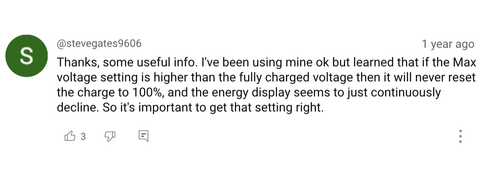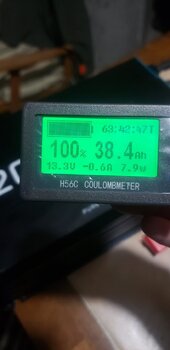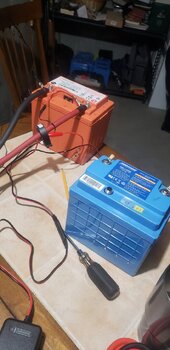Uncledeeds
New Member
- Joined
- Nov 2, 2021
- Messages
- 4
Hello an id like to first wish everyone a happy Xmas an new year to all an your families.I have a question reguarding my purchase of a hall monitor (coulombmeter) as I have just set it up an programing for the first time, I have a question on what I should set the
(Full battery voltage)
It would be 12fv on my meter
I have set the amp hours of the battery which is 38.4
On my charge controller the max charge voltage for these batteries is set 14.4 im pretty sure,its not infront of me.I know the battery at full charge sits at 13.8
The voltage on the battery states 12.8
The batteries I use are low ahr but I get a extremely good deal on these used an always found them to be above 98% ,an I have quite a bit.i will attach a photo of it as well.i think it should be set on the hall monitor at 13.8 so it will read a full charge on the graph at 100% so it will also match the 38.4 ahr as well.im just not sure so thought I'd ask since everyone here im sure knows much more than myself.i can say I have studied literally months on these videos an a few other channels as well,but this one particular is my go to.i hope I have posted this correctly an I apoligize for the very newbie question im sure.i live completely on solar,no grid so this is all very important to me.
Thank you all
Derek
(Full battery voltage)
It would be 12fv on my meter
I have set the amp hours of the battery which is 38.4
On my charge controller the max charge voltage for these batteries is set 14.4 im pretty sure,its not infront of me.I know the battery at full charge sits at 13.8
The voltage on the battery states 12.8
The batteries I use are low ahr but I get a extremely good deal on these used an always found them to be above 98% ,an I have quite a bit.i will attach a photo of it as well.i think it should be set on the hall monitor at 13.8 so it will read a full charge on the graph at 100% so it will also match the 38.4 ahr as well.im just not sure so thought I'd ask since everyone here im sure knows much more than myself.i can say I have studied literally months on these videos an a few other channels as well,but this one particular is my go to.i hope I have posted this correctly an I apoligize for the very newbie question im sure.i live completely on solar,no grid so this is all very important to me.
Thank you all
Derek








